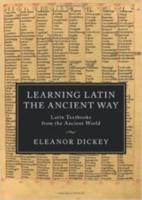
CUP (2016) p/b 187pp £17.99 (ISBN 9781107474574)
Between the 1st and 4th C AD, dialogues were produced to help Greek speakers to learn the Latin of their Roman imperial masters. These dialogues consisted of jolly Cambridge Latin Course-style stories about Everyday Life in the Roman World, with the Greek in one column, one to three words per line, and the Latin opposite it, Loeb-style, translating it word for word. These dialogues were in fact part of larger packages of bi-lingual learning materials, including glossaries, grammars and so on, collected under the jaw-breaking title of the Colloquia of the Hermêneumata Pseudodositheana ‘Dialogues from “Interpretations” by people claiming to be [the grammarian] Dositheus’. Dositheus did in fact write bilingual grammars, and these were attached to the Colloquia on the assumption that he had written the Colloquia too. In this superbly designed volume, D., professor of Greek at Reading University, presents examples from the full range of these materials, mostly with the Greek turned into English. It makes for glorious reading.
Since many of the Greek students wanted to be lawyers, the stories regularly featured law-court scenes – criminal trials, lawsuits, dispute resolutions, manumissions and so on. It is striking how easily the cases are always won, but Romans knew exactly what Greeks wanted to hear. Plenty of other topics relevant to the Greek keen to know how to get on in Rome are featured here: going to the baths, dinner parties, banks, clothes markets, as well as descriptions of life in school for the children, from getting up in the morning to going to school (remember to smooth down your hair on arrival), and being a model pupil (‘you must pay attention because this is the way to make progress’ © Fotherington-Thomas).
Then there are Berlitz-style phrasebooks, of excuses, explanations for absence and useful insults (all very Plautine: Maledicis me, malum caput? Crucifigaris! ‘Do you revile me, villain? May you be crucified!’); stories from the Trojan wars, Aesop’s fables, the Aeneid and model letters. The sections on grammar exemplify explanations of the case system, conjugation and declension. Glossaries cover e.g. homonyms and words relating to sacrifice and entertainment. There is an example of prose composition, and even transliterated words for the Greek student of Latin at outright beginners’ level (e.g. μιλιτια, καστρα, φοσσα, εκουειτης). The book ends with some Latin-Greek texts, including e.g. colloquia, Cicero, Virgil and grammars.
This is certainly the unlikeliest hit-volume of the year, having featured heavily in many national newspapers. Rightly: there is eye-opening material on every beautifully organised page. Everyone attracted to the ancient world should have a copy, especially teachers, and not simply of the languages either. There is much of interest for students of classical studies and ancient history too, and they can pick up a little Latin as they go—the real thing as well.
Peter Jones
